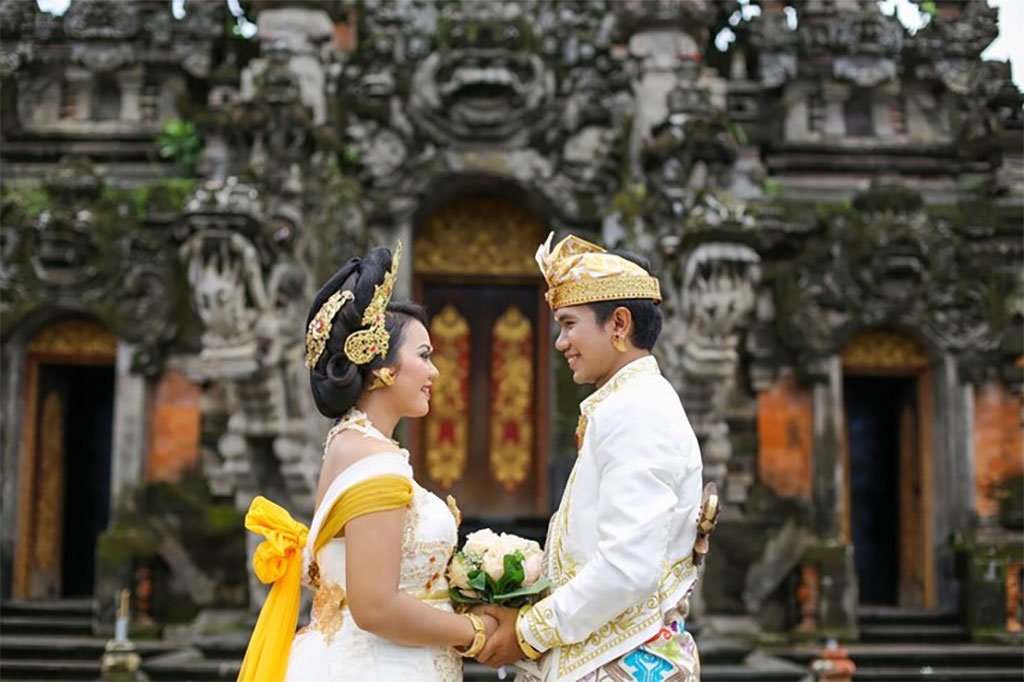Imagine stepping into a world where vibrant colors, intricate rituals, and warm smiles come together to celebrate love, family, and tradition. Attending a Balinese wedding is not just an event—it’s an immersive cultural experience that captures the heart and soul of Bali. From the sacred ceremonies to the lively festivities, every moment is steeped in meaning and beauty.
✨ The Setting: Bali’s Magical Backdrop
Balinese weddings often take place in temples, traditional family compounds, or lush gardens surrounded by the island’s iconic rice terraces. The natural beauty of Bali provides the perfect backdrop for such a sacred occasion. Imagine golden sunlight filtering through frangipani trees, the gentle rustle of palm leaves, and the soft sound of gamelan music echoing through the air. This enchanting environment sets the tone for a deeply spiritual and joyous celebration.
🛕 The Spiritual Significance
Unlike many Western weddings that focus primarily on the union of two people, Balinese weddings are deeply spiritual ceremonies that involve the joining of two families and their ancestors. The ceremony is rooted in Hindu traditions, and it includes numerous rituals meant to bless the couple and honor the divine.
Priests, dressed in white, perform complex rites, chanting mantras and making offerings to the gods. The couple’s families participate in ceremonies to purify the bride and groom and ensure harmony between them and their communities.
🎨 Traditional Attire: A Visual Feast
One of the most striking features of a Balinese wedding is the attire. The bride and groom wear elaborate costumes that are vibrant, detailed, and symbolic. The bride’s dress is often adorned with gold thread, shimmering beads, and intricate lace. Her hair is styled with fresh flowers and golden accessories, often shaped like leaves or flowers. The groom’s attire complements hers with a traditional sarong, sash, and a headdress called “udeng.”
Guests also wear traditional clothes—colorful kebayas for women and batik shirts or sarongs for men—adding to the festive atmosphere.
🍽️ The Feast: A Culinary Celebration
Food plays a central role in Balinese weddings. The feast is an expression of generosity and community. Traditional dishes such as babi guling (roast pig), lawar (a spicy meat and vegetable salad), sate lilit (minced seafood satay), and nasi kuning (yellow turmeric rice) are served to guests.
The food is prepared with great care and often involves the whole community. Eating together is a symbol of unity, and the flavors of the dishes tell a story of Balinese culture and hospitality.
🎶 Music and Dance: The Heartbeat of the Celebration
No Balinese wedding is complete without the captivating sounds of the gamelan orchestra—a traditional ensemble made up of gongs, metallophones, drums, and flutes. The music guides the rhythm of the rituals and adds a mystical aura to the event.
Dance performances, such as the legong or kecak, may also be part of the celebration. These dances tell ancient stories through graceful movements and expressive gestures. Watching these performances feels like stepping back in time, immersed in the island’s rich heritage.
🕊️ Symbolic Rituals You Won’t Forget
Throughout the wedding, guests witness a series of symbolic rituals. For example, the “ngidih” ceremony involves the bride and groom exchanging gifts and offerings, symbolizing respect and gratitude. Another unforgettable moment is the “mekala-kalaan,” where the couple is blessed with holy water to purify and protect their union.
These rituals might seem mysterious at first, but they reflect universal themes of love, protection, and community that resonate deeply, regardless of cultural background.
🤝 Community and Family Bonds
One of the most touching aspects of attending a Balinese wedding is feeling the strong sense of community. Weddings are not just about the couple—they’re a celebration of the extended family and the village. Everyone plays a role, whether it’s preparing food, decorating the venue, or performing ceremonies.
This communal spirit creates a warm, inclusive atmosphere where guests feel like part of something larger than themselves.
📸 Capturing the Memories
Guests often bring cameras or smartphones to capture the vivid colors and joyful moments. Photographers, both professional and amateur, have a field day with the stunning visuals—from the elaborate costumes to the intricate decorations.
But beyond the photos, it’s the feelings of joy, reverence, and connection that make the memories last a lifetime.
🌿 Environmental Harmony
Balinese culture emphasizes harmony with nature, and weddings reflect this philosophy. Decorations often include natural elements like flowers, leaves, bamboo, and rice stalks. Many ceremonies are held outdoors, embracing the island’s natural beauty rather than competing with it.
This connection to the environment adds a serene, almost sacred quality to the wedding.
🧘♂️ A Journey of Learning and Respect
For outsiders, attending a Balinese wedding is also a learning experience. Understanding the symbolism and rituals requires curiosity and respect. Guests often receive explanations from family members or local guides, making the event both educational and deeply meaningful.
It’s a chance to step outside one’s cultural comfort zone and appreciate a different worldview centered on spirituality, community, and tradition.
Final Thoughts
Attending a Balinese wedding is an unforgettable journey into the heart of Balinese culture. It’s a vibrant, colorful, and deeply spiritual event that celebrates not just the love of two people but the strength of family, community, and tradition. Whether you come for the stunning visuals, the delicious food, or the heartfelt rituals, you leave with a richer understanding of Bali’s unique way of life—and a warm feeling that transcends words.
So, if you ever get the chance to attend a Balinese wedding, embrace it fully. It’s a once-in-a-lifetime experience that will leave you inspired and connected in ways you never expected.









